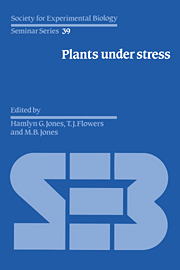Book contents
- Frontmatter
- Contents
- Contributors
- Preface
- 1 Introduction: some terminology and common mechanisms
- 2 The impact of environmental stresses on ecosystems
- 3 Whole-plant responses to stress in natural and agricultural systems
- 4 Photosynthesis and gas exchange
- 5 Regulation of growth and development of plants growing with a restricted supply of water
- 6 Stresses, membranes and cell walls
- 7 Desiccation injury, anhydrobiosis and survival
- 8 Molecular biology: application to studies of stress tolerance
- 9 Environmental control of gene expression and stress proteins in plants
- 10 Plant tissue and protoplast culture: applications to stress physiology and biochemistry
- 11 Breeding methods for drought resistance
- 12 Selection for physiological characters – examples from breeding for salt tolerance
- 13 Prospects for improving crop production in stressful environments
- Index
2 - The impact of environmental stresses on ecosystems
Published online by Cambridge University Press: 16 March 2010
- Frontmatter
- Contents
- Contributors
- Preface
- 1 Introduction: some terminology and common mechanisms
- 2 The impact of environmental stresses on ecosystems
- 3 Whole-plant responses to stress in natural and agricultural systems
- 4 Photosynthesis and gas exchange
- 5 Regulation of growth and development of plants growing with a restricted supply of water
- 6 Stresses, membranes and cell walls
- 7 Desiccation injury, anhydrobiosis and survival
- 8 Molecular biology: application to studies of stress tolerance
- 9 Environmental control of gene expression and stress proteins in plants
- 10 Plant tissue and protoplast culture: applications to stress physiology and biochemistry
- 11 Breeding methods for drought resistance
- 12 Selection for physiological characters – examples from breeding for salt tolerance
- 13 Prospects for improving crop production in stressful environments
- Index
Summary
Introduction
The use of stress terminology has been discussed in Chapter 1, where it was pointed out that the value of the term stress in indicating some adverse force or influence lies in its extreme generality, without the need for a precise quantification. Nevertheless it is appropriate that a scientific discipline should be concerned with definable quantities. This will be the starting point for this paper, which will follow the example of Levitt (1972) who applied the concepts and terminology of mechanical stress (force per unit area) and strain (a definable dimension change) to the study of plant responses to the environment. This approach will be developed here in an attempt to incorporate the philosophies behind stress effects into a general treatment of the responses of ecosystems to adverse environmental conditions.
Mechanical stress
The mechanical concepts of stress are outlined in Fig. 1, with the axes reversed from that employed by mechanical engineers. The three salient features of a stress-strain response curve are shown in Fig. la. Initial increases in stress cause small strains but beyond a threshold, the yield stress, increasing stress causes ever increasing strains until the ultimate stress, at which point fracture occurs. The concept of the yield stress is more clearly realised when material is subjected to a stress and then relaxed to zero stress (Fig. lb). In this case a strain is developed but is reversed perfectly – elastically – to zero strain at zero stress. In contrast, when the applied stress exceeds the yield stress (Fig. lc) and the stress relaxes to zero, the strain does not return to zero.
- Type
- Chapter
- Information
- Plants under StressBiochemistry, Physiology and Ecology and their Application to Plant Improvement, pp. 11 - 30Publisher: Cambridge University PressPrint publication year: 1989
- 1
- Cited by



